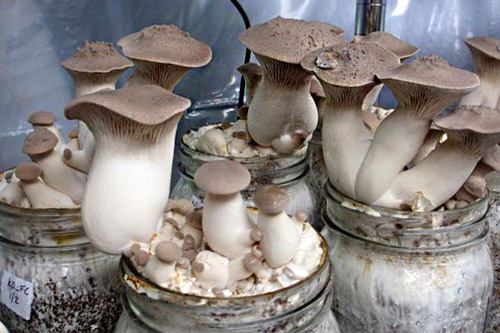Before you start growing mushrooms, it’s a good idea to familiarize yourself with the basics of mushroom cultivation and read a few mushroom-related articles on this blog, in the Mushrooms at Home section.
There are at least 10 reasons to grow mushrooms . It’s fascinating, beneficial for you and your kids’ overall development, and helps recycle organic waste.
You will achieve greater success if you understand the general lifecycle of mushrooms. Knowing basic terms like “mycelium,” “substrate,” and the mechanism of mushroom nutrition will make the process easier and help you avoid mistakes.
Explore the types of mushrooms available for sale. Learn which ones are easier to grow, which substrate to choose for mushrooms , and how much space you will need for growing them.
Every mushroom grower starts with a mushroom bed – a substrate or material populated with mycelium. You need to know more about mushroom beds . Once you succeed, you’ll face the challenge of producing your own mycelium . It’s not difficult if you follow the rules. Plus, it can be completely free.
One key piece of the mushroom puzzle is the substrate on which the mycelium will grow its mushrooms. There are several types of mushroom substrates and materials to choose from. Every substrate requires special preparation, as other microscopic competitors (like mold and pathogenic fungi) will compete with the mushrooms for nutrients and win. On the substrate preparation for mushrooms page, you will find detailed instructions on various sterilization methods.
If you’re just starting out, review the list below. The recommendations will help you save time and avoid some common mistakes.
Not enough moisture. Mushrooms are primarily made of water. Mycelium needs a moist environment. If the mycelium dries out, it won’t produce fruit. If your mushrooms grow outdoors or on an open balcony, pay special attention to moisture levels.
Too much moisture. A soggy substrate will develop mold or begin to rot. To avoid overwatering, create drainage in the bags with the substrate. Ventilate the bags covering the mycelium bags before fruiting.
Unsterilized substrate, mold appears. Good mushroom mycelium is constantly fighting for its habitat with bad fungi and mold. Mold spores are everywhere – give them even a hint of a suitable environment, and they’ll thrive. If you’ve sterilized the substrate, you’ll be fine. Wash your hands when handling mushrooms, inoculating mycelium, and grow in a clean, ventilated space. Everything you need to know about substrate sterilization is in this article .
Mushrooms suffocate. While mushrooms don’t need as much oxygen as we do, they still require it. If mushrooms are forced to breathe carbon dioxide, they’ll grow thin, small, and without caps. Areas with poor air circulation, like small storage rooms without ventilation, are unsuitable for mushroom growing. In extreme cases, the room must be ventilated several times a day. However, fresh air shouldn’t bring contaminants or dryness. This balance seems difficult at first but becomes easier over time.
Unsuitable environment. When purchasing mycelium, familiarize yourself with the environmental requirements of that specific type. A mushroom that needs warmth won’t grow in the cold, and varieties that develop on logs will struggle on straw. Follow the simple instructions, and you’ll succeed.
Low-quality mycelium. The mushroom bed must be fresh. When choosing where to buy mycelium, read reviews and don’t skimp on a few pennies. Especially since you won’t need to buy mycelium regularly – I’ll teach you how to grow mycelium from your own mushrooms . Try to find a local supplier, so the mycelium doesn’t have to be shipped – that’s stressful for it. Use purchased mycelium immediately – it weakens rapidly. In extreme cases, you can store the mycelium in the refrigerator for a couple of days.
Lack of understanding between the mushroom and the grower. You don’t have to be a pro, but you need to know the basics. How mushrooms feed, reproduce, live, and die – that’s just a few Wikipedia articles, a half-hour of research. If you understand the life of a mushroom, you’ll be more successful in growing them. You may even become more interested in mycology beyond just for general knowledge.
When patience runs out… Growing mycelium takes time. And when you don’t see results for a few weeks, you might feel like giving up. For example, morels develop for months or even years! Or growing on logs – it’s slow but rewarding. Mushroom growing can be a frustrating hobby for the impatient. Endure until the first harvest, and everything will go smoothly from there. Once you know what to expect, the waiting time won’t be as frustrating – you’ll enjoy the process. If mycelium delays fruiting but doesn’t show signs of mold (red, green, or black), you may just need to increase humidity or temperature. Every failure is an experience. Treat mushroom growing as an adventure – you’ll definitely enjoy it.







